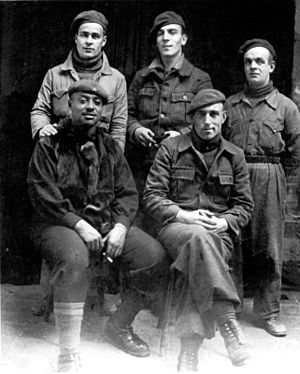Walter Benjamin Garland facts for kids
Quick facts for kids
Walter Benjamin Garland
|
|
|---|---|

Garland (seated, left).
|
|
| Birth name | Walter Benjamin Stephen Garland |
| Born | 27 November 1913 New York |
| Died | January 1974 (aged 60) Cleveland |
| Allegiance |
|
| Service/ |
|
| Years of service | 1931–1945 |
| Rank | Lieutenant, First Sargent |
| Battles/wars | Battle of Jarama, Battle of Brunete |
Walter Benjamin Garland (born November 27, 1913 – died January 1974) was an American soldier, activist, and politician. He was known for volunteering to fight in the Spanish Civil War. Garland joined the XV International Brigade to support Republican Spain. After the war, he became a member of the Communist Party USA and even ran for political office in New York. He also worked as a bodyguard for the famous singer and activist Paul Robeson. Garland passed away in Columbus, Ohio in 1974.
Contents
Early Life and Education
Walter Garland was born in New York City in 1913. When he was 18, in 1931, he joined the United States Army. He served for two years and left the army in 1935 as a Private First-Class.
After his time in the army, Garland went to Brooklyn College. There, he studied mathematics. He also worked for NBC, helping to arrange music for the show Your Hit Parade. In 1935, he joined the Communist Party USA. He was also active in the National Negro Congress, a group that worked for civil rights.
Fighting in the Spanish Civil War
The Spanish Civil War started in 1936. Many people around the world who believed in communism decided to help Republican Spain. Walter Garland was strongly against fascism, which is a type of government where one leader has total power and often uses force. Because of his beliefs, he volunteered to fight in Spain.
He sailed to France in January 1937. From there, he traveled to join the Republican forces. In Spain, he became part of the Abraham Lincoln Battalion. Because he had military experience, he was made a section commander.
Wounded in Battle
On February 27, 1937, Garland was hurt during the Battle of Jarama. While he was recovering, he was chosen to attend officer training school. He then returned to the front lines as a commander of a machine gun battalion, which was called the Washington Battalion.
In July 1937, Garland was wounded a second time. This happened during the Battle of Brunete, which was a defeat for the Republican side. After this, he was promoted to captain. He was given command of the Canadian Mackenzie–Papineau Battalion while they were training.
Spreading the Message
In August, Garland worked with famous writer Langston Hughes and activist Harry Haywood. They broadcast a radio message to the United States from Spain. Their goal was to get more support for the Republican cause.
In October, Garland was ordered to return to the United States. His mission was to raise money and find more volunteers for the International Brigades. Once back home, he tried to convince the U.S. Congress to allow weapons to be sent to Republican Spain.
Political Efforts
In 1938, Garland ran for office in New York as a candidate for the Communist Party. He ran for the same office again in 1940. Even after the Republican side lost the war in 1939, Garland continued to be involved with groups like the Friends of the Abraham Lincoln Brigade.
World War II Service
Before World War II started, the Federal Bureau of Investigation (FBI) watched Garland. They considered him a person who might be dangerous because of his communist activities and his service in Spain.
After the United States joined World War II, Garland tried to rejoin the U.S. Army. He was first turned down but then accepted. He joined the 731st Military Police Battalion at Fort Wadsworth in Staten Island. Garland became an instructor there. He taught soldiers how to use mortars and machine guns. He also taught map-making and shared his experiences from the Brunete campaign. He even invented a new gun sight for machine guns on scout cars. Garland was promoted to first sergeant but was not sent overseas, even though he asked many times.
After the Wars
After World War II ended, Garland and other African-American veterans who fought in Spain formed a group called the United Negro Allied Veterans Association. Garland kept supporting communist causes in New York. He was often at the Ben Davis Club in Harlem, which supported communism. He also helped organize efforts for the International Workers Order. In 1949, he traveled with Paul Robeson and worked as his bodyguard.
In 1952, Garland left the Communist Party USA. The FBI continued to monitor him until he passed away. Walter Garland died in January 1974 in Columbus, Ohio.

